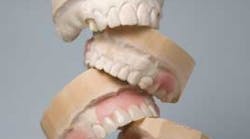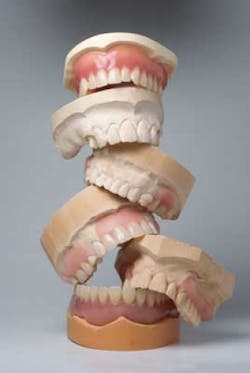by Mark Wilhelm, DMD, MSD
How often do you deliver a multi-tooth fixed prosthesis and need to adjust the bite? How about the bite on your complete denture? Many of the referrals I get deal with bite issues on delivered prostheses. The patients can tell you the bite is wrong. Why does this happen? There are a few reasons why this is so. Let’s look at one that is generated by the patient. If the patient has a dysfunctional occlusion, then any bite registration that you try to generate from them will be incorrect. Their central pattern generator is not set to repeat jaw positions. This means that the central pattern generator must be erased before attempting to record any position. Remember that you can only use the patient’s MIP (maximum intercuspal position) when they have acceptable function. This allows single-tooth dentistry. When dysfunction is present, it must be corrected, which means that you cannot do single-tooth dentistry. To correct it, you need to find a place that allows all the posterior teeth to contact at the same time.This is where you will be required to record a jaw relationship that uses some repeatable position which will be centric relation or adapted centric position. This means that you will record a JAW position. Then maybe this jaw position will permit an occlusal adjustment to create the place where the back teeth will contact at the same time or you will restore the teeth to that position. Then in the future you can do single tooth dentistry and have the patient close into this new and acceptable MIP. To record a jaw position that is repeatable, we will assume that your patient does not actively have TMD issues. Then we must make the central pattern generator in the brain forget by a process called "deprogramming." We can accomplish deprogramming using a custom deprogrammer or by using devices such as a leaf gauge or Lucia jig. The key to this is to not allow posterior tooth contact during closure. Some people need a long time to deprogram; others need only five minutes. To determine if a patient is deprogrammed, the contacts of the anterior teeth on the deprogrammer should be in the midline, as close to the desired OVD as possible, and should only constitute a single spot. This single, tiny contact must be repeatable over and over with a “tap, tap, tap.” Then, record the jaw relationship with the deprogrammer still in place. By following this up with careful lab protocol, we can accurately mount casts and end up with prostheses that require little to no adjustment at delivery.Mark Wilhelm, DMD, MSD, has been in private practice in St. Paul, Minn., since 1990, where he is focused on cosmetic and sedation dentistry advanced restorative procedures, and dental implants. After graduating from the University of Illinois, Dr. Wilhelm received his doctorate of dental medicine in 1985 from Southern Illinois University School of Dental Medicine. He continued his education to achieve a masters of science dentistry, and completed specialty certificates in prosthodontics and maxillofacial prosthetics at Indiana University. Dr. Wilhelm is an author, consultant, mentor, and frequent speaker to dentists and the public on techniques that enhance oral health. He presents many seminars on implant dentistry and advanced restorative procedures to family and cosmetic dentists in the Minnesota area. Visit his website at www.imagineyoursmile.com.








